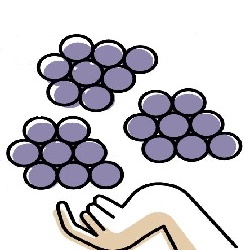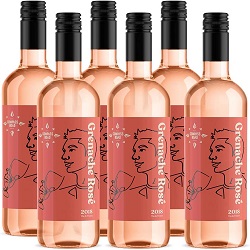Rosé Wine Vinification

| HarvestingBlack grapes are harvested and sorted. |
CrushingHarvested grapes are crushed to release the must. | |
MacerationA short maceration with the skins creates a pink juice. | |
PressingPressing separates the juice from the skins, seeds, and stems. | |
FermentationYeasts transform the pink grape juice into wine (sugar into alcohol). | |

| BottlingAfter the fermentation, the rosé wine is bottled. |
Level 1
This a simplified description of how to make a rosé wine.
A more complete description is found in Level 2.
Harvesting and Sorting
The first step to produce a rosé, is to harvest black grapes.
Rosé wines are made from black grapes.

Sorting grapes before crushing
After carefull harvesting, the grape clusters are sorted for quality.
Unripe, diseased, and damaged grapes, bugs and leaves are removed.
Crushing
After sorting, the grapes are crushed to crack the skins and release the must.
Must is the crushed grape juice that contains flesh, skins, seeds, and stems.

Grapes are crushed to release the must
Latin Vinum Mustum = Young Wine"
Short Maceration

Must interacting with the skin in the maceration process
Maceration is the process where the rosé wine receives its color.
The color comes from this skin contact with the juice.
Pressing

Pressing separates the pink juice from the skin, seeds, and stems.
Alcoholic Fermentation

Juice + Yeast = Alcohol + CO2
Alcoholic fermentation transforms grape juice into wine.
Yeasts transform the sugar in the juice into alcohol (and CO2).
Differences Between White and Rosé
White wines are made from white grapes.
Rosé wines are made from black grapes.
White grapes are pressed immediately after crunching, to avoid any skin contact.
Rosé grapes are macerated with the skins to absorbe taste and color from the skins.